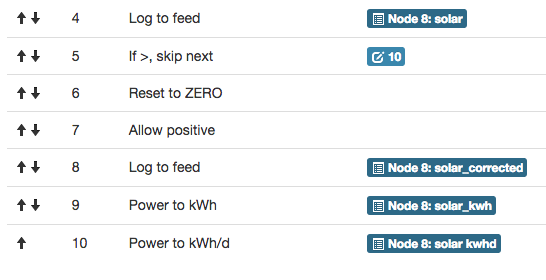Continuing the discussion from New install - Do I need to calibrate my CTs or Feeds?:
In the related topic I explained that my solar panels seemed to be able to produce with moonlight 
Robert explained that what I have is called ‘circulating vars’(Volt Amperes Reactive)
To put simple, at night you see still some watts flowing in and for sure this is not the case since it it is pitch-black outside. Sometimes this can happen when you have ‘noise’ near your CT clips (you can test by unclipping and hanging them in the air and move around the spot and see if you get some reading or a nice zero like me).
In my case it isn’t noise, hence my totaling for the day is over estimated by x watts * hours night time.
Since there isn’t much I can do, I decided to try to shunt that out and with the help of Paul I finally edited my process list like following image and it works quite well for me.

You start the usual logging to a feed, then set a condition with a threshold (in my case 10W, you have to set this according what you have at night) and if below this threshold, the feed is reset to zero. If you are above the threshold, you do nothing. The result is passed to a new logging of the feed with another name … and from there you can do whatever you want.
I added ‘allow positive’ since with moments (no clue why honestly) it records negative values … and for what I know, my panels don’t generate solar rays (yet) 
2 Likes
Are the negatives not the inverter drawing from grid while “asleep” overnight?
I get -4w usually to my SMA inverter once the sun goes down.
if it was negative, you could assume yes
But in my case
- it is positive so production and not consumption
- looked at it via a classic amp meter in the loop and it showed near nothing
@glyn.hudson
Bumping this thread up as the solution I implemented in my local hosted emoncms is in the first post.
I’m trying to replicate this on emons.org but I can’t find the same operators in the list.
Guess there is a good reason for it (cpu usage ??) As I’m going to participate in the co op research I’m pushing all the data to emoncms.org but I can’t ‘correct’ my solar production ‘error’ at night since I miss “if >, skip next” … can this operator be implemented or not ?
If not I need to find some other solution 
Eric,
I think you’ll need to edit your sketch and send the revised (edited) value - edit the RF payload in an emonTx, or the serial data in an emonPi - to emoncms. If you wish, you could send both the raw and edited data separately as two fields, and choose which to use in emoncms.
will have a few more emontx next week end, will learn how to do that on them (at least I don’t mess with the active one) once all is ok I’ll see how it goes and then I’ll do the same on the unit that is already in service.
Problem is that the voltage is far from stable here … for a 230V line we are going from 225 to 245. That’s fun of being end of the line with cables dating back to WWII (or somewhere in that period) 




